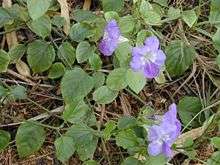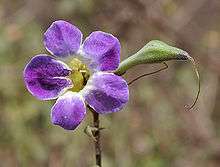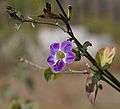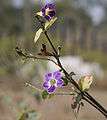Asystasia gangetica
| Chinese violet | |
|---|---|
 | |
| Asystasia gangetica from Kalepolepo, Maui | |
| | |
| Asystasia gangetica micrantha from Amanzimtoti, South Africa | |
| Scientific classification | |
| Kingdom: | Plantae |
| (unranked): | Angiosperms |
| (unranked): | Eudicots |
| (unranked): | Asterids |
| Order: | Lamiales |
| Family: | Acanthaceae |
| Genus: | Asystasia |
| Species: | A. gangetica |
| Binomial name | |
| Asystasia gangetica (L.) T.Anderson | |
| Synonyms | |
| |
Asystasia gangetica is a species of plant in the Acanthaceae family. It is commonly known as the Chinese violet, coromandel[2] or creeping foxglove.[3] In South Africa this plant may simply be called asystasia.[4]

Description
This plant is a spreading herb or groundcover, reaching 600 mm in height[3][4] or up to 1 m if supported.[5] The stems root easily at the nodes.[3] The leaves are simple[3] and opposite.[5] The fruit is an explosive capsule which starts out green in colour, but dries to brown after opening.[5]
Subspecies
- A. g. gangetica, has larger (30–40 mm long) blue or mauve flowers.[5]
- A. g. micrantha (Nees) Ensermu, has smaller (up to 25 mm long.[5]) white flowers with purple markings on the lower lip.[4]
Distribution
Widespread throughout the Old World Tropics, and introduced into tropical Americas[6] and Hawaii, where it has become naturalized.[2] Both subspecies of this plant have been introduced to Australia where A. g. micrantha is on the National Environmental Alert List and must be reported when found.[5] The original range of the subspecies is unclear,[5] but it is likely that A. g. gangetica was limited to Asia, and A. g. micrantha was limited to Africa.[3]
Reproduction
Ernest Akamine (1947)[7] found that there were no apparent dormancy mechanisms operating in the seeds, which germinated freely 135 days after being expelled from parent plants. Flower production can begin as early as 40 days after germination, with seed development beginning after 57 days, facilitating the production of viable seed in as little as 72 days.[8] The seeds are then expelled explosively upon ripening via hooked retinacula (pictured).
-

Asystasia gangetica Seed head
Uses
In some parts of Africa, the leaves are eaten as a vegetable and used as an herbal remedy in traditional African medicine.[9] The leaves are used in many parts of Nigeria as a traditional African medicine for the management of asthma.[10] It is also used as an ornamental plant.[3]
Ecological Significance
This is an important plant for honeybees, butterflies and other insects.[3][4] In southern Africa there are at least seven species of butterfly and moth that use A. g. micrantha as a larval foodplant; Junonia oenone, Junonia hierta, Junonia natalica, Junonia terea, Protogoniomorpha parhassus, Hypolimnas misippus[11] and Microplexia costimaculalis.[12] The vigorous growth of A. g. micrantha in tropical regions.[3] makes it a weed which can smother certain indigenous vegetation where it has been introduced.[5]
Gallery
-
From Amanzimtoti, South Africa.
-

From Hyderabad, India.
-

From Hyderabad, India.
-

Found in Malaysia
-

Macro of Asystasia gangetica in Malaysia
-
_Anna_Bay%2C_NSW%2C_Australia.jpg)
Asystasia gangetica Anna Bay, NSW, Australia
-

Asystasia gangetica smothering rainforest understory. Gold Coast, QLD, Australia
References
- ↑ Jstor Plant Science, Asystasia gangetica synonyms: http://plants.jstor.org/taxon/synonymy/Asystasia.gangetica, retrieved 28 July 2010
- 1 2 Plants of Hawaii: Asystasia gangetica: http://www.hear.org/starr/images/species/?q=asystasia+gangetica&o=plants, retrieved 28 July 2010
- 1 2 3 4 5 6 7 8 South African National Biodiversity Institute: Asystasia gangetica: http://www.plantzafrica.com/plantab/asystasiagan.htm, retrieved 28 July 2010
- 1 2 3 4 Pooley, E. (1998). A Field Guide to Wild Flowers; KwaZulu-Natal and the Eastern Region. ISBN 0-620-21500-3.
- 1 2 3 4 5 6 7 8 Weed Identification, Australia: http://www.weeds.org.au/cgi-bin/weedident.cgi?tpl=plant.tpl&state=&s=&ibra=all&card=H34, retrieved 28 July 2010.
- ↑ Jstor Plant Science, Asystasia gangetica: http://plants.jstor.org/taxon/Asystasia.gangetica, retrieved 28 July 2010.
- ↑ Akamine, Ernest (1947). "Germination of Asystasia gangetica L. Seed with Special Reference to the Effect of Age on the Temperature Requirement for Germination". Plant Physiology. 4. 22: 603–607. doi:10.1104/pp.22.4.603. Retrieved 30 May 2014.
- ↑ Sahid, I. B; Shukor, J. A (1998). "Effects of water stress, shading and clipping on growth and development of Asystasia gangetica". Plant Protection Quarterly. 3. 13: 140–142.
- ↑ Grubben, G.J.H. & Denton, O.A. (2004) Plant Resources of Tropical Africa 2. Vegetables. PROTA Foundation, Wageningen; Backhuys, Leiden; CTA, Wageningen.
- ↑ Akah, P.A.; Ezike, A.C.; Nwafor, S.V.; Okoli, C.O.; Enwerem, N.M. (2003). "Evaluation of the anti-asthmatic property of Asystasia gangetica leaf extracts". Journal of Ethnopharmacology. 89 (1): 25–36. doi:10.1016/S0378-8741(03)00227-7. PMID 14522429.
- ↑ Williams, M. (1994). Butterflies of Southern Africa; A Field Guide. ISBN 1-86812-516-5.
- ↑ Guillermet, 2005. Les Hétérocères ou papillons de nuit, de l'île de La Réunion. Volume 1. Famille des Noctuidae Quadrifides. - — :1–532, pls. 1–13.
External links
- PROTAbase on Asystasia gangetica
- Asystasia gangetica
- Asystasia gangetica
- Dressler, S.; Schmidt, M. & Zizka, G. (2014). [http://www.africanplants.senckenberg.de/root/index.php?submitForm=true&page_id=77&searchTextMenue=Asystasia+gangetica&filterRegionIDs[]=6&filterRegionIDs[]=1&filterRegionIDs[]=2&filterRegionIDs[]=3&filterRegionIDs[]=5 "Asystasia gangetica"]. African plants – a Photo Guide. Frankfurt/Main: Forschungsinstitut Senckenberg.
| Wikimedia Commons has media related to Asystasia gangetica. |
| Wikispecies has information related to: Asystasia gangetica |